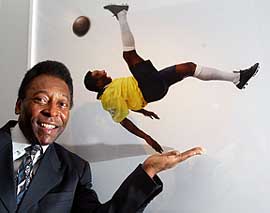Amongst the knowledgable, Brazilian soccer is viewed with an admiration bordering on mysticism. (The only U.S. analogy I can think of is the way in which the Dream Team was viewed in the Barcelona Olympics.) There seems to be an endless supply of ludicrously talented, preposterously named (and mononymed) soccer artistes emigrating from the Amazon to Europes biggest (and middlest and smallest as well...) clubs. How can one country be so much better at this?
The answer usually given is that Brazillian soccer is its culture and its culture is its Futebol (pronounced roughly FU-chee-ball.) To try and gain a better understanding, I picked up Bellos' Futebol: Soccer the Brazilian Way.
While there is certainly a lot to like here, cultural/sociology/anthropology isn't always my thing (that would be PhD Mama Pooh's bag, baby) - give me the sports damnit! And there's plenty of that here, with my favorite bits unsurprisingly concerning the Brazilian National team.
 First, there are the almost messianic expectations placed upon the squad. They must not only win, but to do so convingly and with suitable Samba flair to credit "the beautiful game". The extent to which there is a trade-off between "attractivness" and "winning" is greater in soccer than in any comparably popular American sport, with basketball being the only real comparison. Even there, there is an order of magnitude between the dour tactics of the early 90's Knicks, for example and with what current Chelsea manager Jose Mourinho once famously described as bringing the team bus and leaving it in front of the goal. Yet the Samba boys must do both. In fact, many were not satisfied with their 1994 World Cup triumph because of the perceived negativity of their tactics (embodied by tough-guy midfielder Dunga, who in any other national side would have been recognized as simply world class.)
First, there are the almost messianic expectations placed upon the squad. They must not only win, but to do so convingly and with suitable Samba flair to credit "the beautiful game". The extent to which there is a trade-off between "attractivness" and "winning" is greater in soccer than in any comparably popular American sport, with basketball being the only real comparison. Even there, there is an order of magnitude between the dour tactics of the early 90's Knicks, for example and with what current Chelsea manager Jose Mourinho once famously described as bringing the team bus and leaving it in front of the goal. Yet the Samba boys must do both. In fact, many were not satisfied with their 1994 World Cup triumph because of the perceived negativity of their tactics (embodied by tough-guy midfielder Dunga, who in any other national side would have been recognized as simply world class.)And further, Bellos describes the manner in which the national team has been coopted as a marketing entity, both by sponsors such as Nike, and by domestic club teams, who rely on transfer fees from European and Asian squads for their best players. The second point was new to me, in the sheer number of players who get chosen to play for Brazil doesn't neccesarily indicate the depth of 'international class' talent, but rather a recognition of the increased marketability of appearing just once in the famed yellow shirt.
 But my absolute favorite passages concern the contrast between Brazil's two great heros of the golden age of the 60's and 70's, Pele and Garrincha. Pele is of course a world-wide star, one of the few soccer players to have any sort of name recognition in the U.S. Garrincha to many is simply another name from the assembly line of Brazillian greats.
But my absolute favorite passages concern the contrast between Brazil's two great heros of the golden age of the 60's and 70's, Pele and Garrincha. Pele is of course a world-wide star, one of the few soccer players to have any sort of name recognition in the U.S. Garrincha to many is simply another name from the assembly line of Brazillian greats. However, within Brazil, the story is much different: Pele is respected, though not greatly loved, while Garrincha is an absolute icon. Part of this is stylistic: Pele is Jordan, Garrincha is Hot Sauce. But part is also attitude: Pele is seen as a worldly, corporate sellout. Garrincha was a flawed, provincial, almost savant-like figure who seemed to care less about winning than about using the game as an exhibition for his skills. The explication of this dichotomy is the highlight of the piece.
However, within Brazil, the story is much different: Pele is respected, though not greatly loved, while Garrincha is an absolute icon. Part of this is stylistic: Pele is Jordan, Garrincha is Hot Sauce. But part is also attitude: Pele is seen as a worldly, corporate sellout. Garrincha was a flawed, provincial, almost savant-like figure who seemed to care less about winning than about using the game as an exhibition for his skills. The explication of this dichotomy is the highlight of the piece.Verdict: Perhaps a little too serious for what I was expecting, but a good read none the less.
3 comments:
I hope you have read The Miracle of Castel di Sangro. If not, consider it highly recommened.
On the pile (a very thick pile, but on the pile)
And then there's the thing about the legs.
Post a Comment